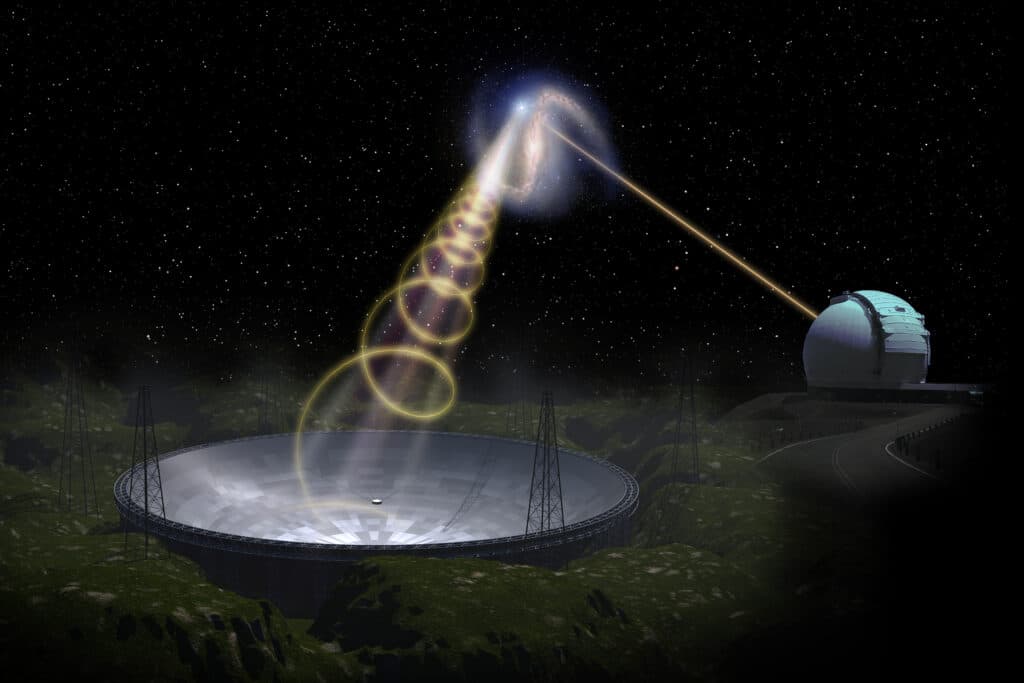We’re receiving a telephone call from outer space. Except, we don’t know who it’s from. Like something out of Close Encounters of the Third Kind, we have no idea what, outside of one possibility, or who might be giving us a call. And this call is coming in the form of what’s called “fast radio bursts.”
Scientists have been trying to unravel a series of mysteries we’ve only just begun untwining 15 years ago. (I, for one, welcome our new overlords, should they come.)
This mystery begins with Dr. Bing Zhang, University of Nevada Las Vegas’s Nevada Center of Astrophysics — he says we need to go back to the drawing board.
A little more than 15 years ago, we discovered our first encounters with radio waves. These electromagnetic waves were detected and identified as fast radio bursts (FRB). They’re only a millisecond long, but these explosions across time-space have just now been felt. Each burst produces the annual power output of our sun, to give you an idea.
A series of new bursts are making scientists question what they previously knew about these FRBs. These were detected by a global team led by Zhang. These new observations were found using the monolithic Five-Hundred-Meter Aperture Spherical Radio Telescope (FAST) in China. The Chinese team detected 1,863 bursts in 82 hours over 54 days from an active FRB source called FRB 20201124A.
“This is the largest sample of FRB data with polarization information from one single source,” says Kejia Lee, a member of the team at Peking University, in a statement.
Our previous understanding and thought were that fast radio bursts originated from a magnetar, a city-sized neutron star that emits incredibly powerful electromagnetic waves.
However, this is being challenged as the new observations give scientists more information to play with. “These observations brought us back to the drawing board,” says Zhang, “It is clear that FRBs are more mysterious than what we have imagined. More multi-wavelength observational campaigns are needed to further unveil the nature of these objects.”
To deepen everyone’s insatiable curiosity, deep-space fast radio bursts are currently of unknown origin and the only one, aforementioned above, was our only idea as to what could cause the origins of these FRBs. Another caveat is the latest observations gave a “Faraday rotation measure” — basically, the strength of the magnetic field and density of particles in the vicinity of the supposed FRB source came as short, irregular bursts.
Mysteriously, the latest observations had variations during the first 36 days of watching and were suddenly silenced in the last 18 days of the study. Whatever or whoever is trying to send us signals is up to debate so far.
Scientists may need to rethink their current understanding of fast radio bursts.
“I equate it to filming a movie of the surroundings of an FRB source, and our film revealed a complex, dynamically evolving, magnetized environment that was never imagined before,” notes Zhang. “Such an environment is not straightforwardly expected for an isolated magnetar. Something else might be in the vicinity of the FRB engine, possibly a binary companion.”
With more questions than answers and no caller-ID, we can’t tell who’s buzzing our lines. The intrepid scientists trudge along further to seek an answer to a potentially frightening question; Do we want to answer the call of whatever or possibly whoever is sending us these FRBs?
I might let that one go to voicemail.
The research paper is publish in the journal Nature.












